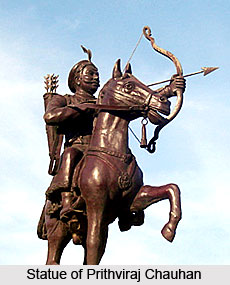 Tomaras, also known as Tanwar or Toor, are descendants of the Chandravanshi or Moon dynasty. Initially they were the feudatory chiefs of the Pratiharas. History also states that the Tomaras are descendants from Arjuna. Thereafter, they became independent, made Delhi as their base and established their kingdom in Haryana and parts of the Punjab. Their independence was not long lasting and in the mid twelfth century Chauhana Vigraharaja III took the Tomaras under his suzerainty. Tomara clans include Kshatriyas -Rajput, Jats and Gurjars.
Tomaras, also known as Tanwar or Toor, are descendants of the Chandravanshi or Moon dynasty. Initially they were the feudatory chiefs of the Pratiharas. History also states that the Tomaras are descendants from Arjuna. Thereafter, they became independent, made Delhi as their base and established their kingdom in Haryana and parts of the Punjab. Their independence was not long lasting and in the mid twelfth century Chauhana Vigraharaja III took the Tomaras under his suzerainty. Tomara clans include Kshatriyas -Rajput, Jats and Gurjars.
Tomaras have various sub-clans. The various clans are given below:
Jatu Rajputs
Jatu Rajputs are descendents of Thakur Jatu Singh. They resided in surrounding villages of Bhiwani in Haryana. There are a significant number of villages of Tanwar Rajputs. A few known ones among these villages are Luhari Jatu, Bawani Khera, Devsar, Haluwas Bapora, Chhapar, and Paluwas.
Janghara Rajputs
They are considered as large and turbulent branch of the Tomar Rajput clan. They were recruited by the British Indian Army. The chaotic nature of the tribe is enhanced by the origin of the name Janghara being derived from the words meaning "the men who hunger for war". The Janghara separated from the main Tomar branch in disgust after Delhi was lost to the Chauhans.
Jarral Rajputs
Jarral Rajputs gained status after their conversion to Islam in the 12th century. They are descendants of Pandavas and ruled Kalanaur in North India. They fought against Muhammad Ghori in both the battles of Tarain joining Prithviraj Chauhan of Ajmer. They are wild and resilient to battles by nature. Jarrals were engaged in continuous combats and in the process expanded their state in great length and width of the Punjab Hills. Jarral Rajputs are the highest castes of Tomar who converted to Islam. At present they reside in India, Jammu & Kashmir, Punjab and other parts which are now in Pakistan.
Pathania Rajputs
Pathania Rajputs are descendants of Raja Jhet pal, younger brother of Jaipal Tuar of Delhi. He established his kingdom at Paithan, now called Pathankot. They are known for their resistance against foreign rule, which they proved by battling the invaders. This clan had received three Maha Vir Chakras and many other gallantry awards while serving in the British Army of India.
Janjua Rajputs
Janjua Rajputs claim that they are the descendants of the Pandava dynasty through the Pandava Prince Arjun.
Beruari
Beruari is one of the most dominating Rajput sub caste of eastern Uttar Pradesh. The present day Balia and Mirzapur districts were once governed by Sudras of Berua caste. There are many villages belonging to this clan in Bihar as well. Hati is one of the prominent villages of this clan. They are treated as superior Rajput clans in Bihar. There are many sub branches also like Badwar, Katiyar, Birwar, Jinwar, etc.
The Tomaras are scattered over various parts of North India. They can be found in Delhi, Haryana, Madhya Pradesh, Punjab, and Rajasthan. They also reside in Punjab, Western Uttar Pradesh, Bewar and parts of Himachal Pradesh, western Rajasthan, Northern Madhya Pradesh and Gujarat.



















